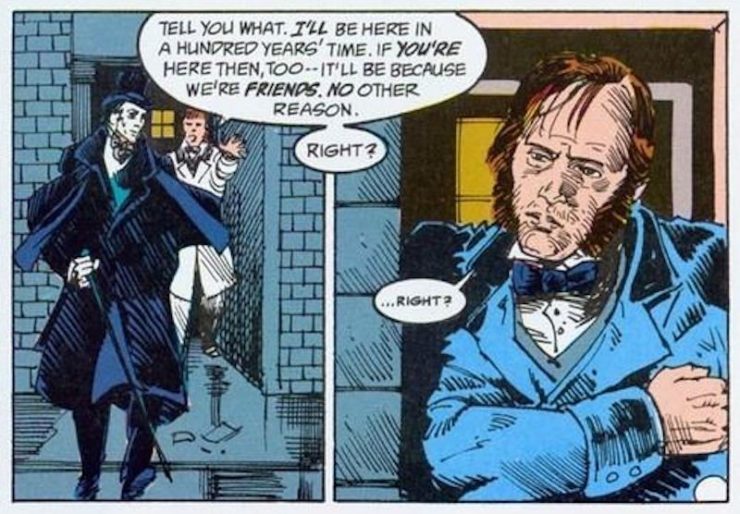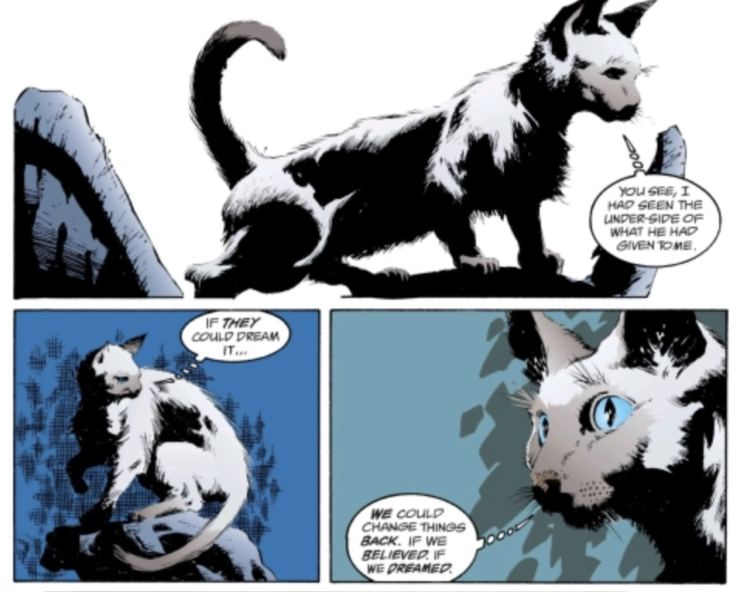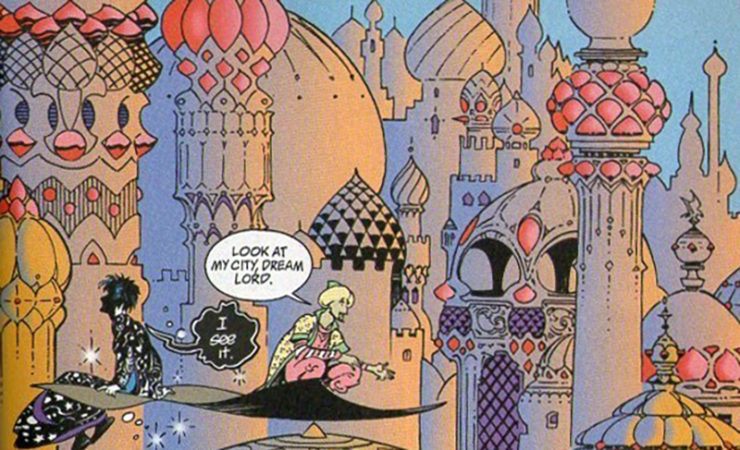We’re just under two weeks away from Netflix’s Sandman adaptation. It’s slated to release on August 5th, bringing Morpheus and his mystical companions to our screens for journeys through the Dreaming, the Waking World, and every realm in between.
Based on the casting and trailers to date, it appears we’ll be treated to some core Sandman stories. Preludes & Nocturnes (Volume one) and The Doll’s House (Volume two) seem likely to make up much of season one. I’m also holding out hope Gwendolyn Christie’s casting as Lucifer means we’ll get Season of Mists (volume four), a marvelous arc about Hell and its rule.
But for all the epic, world-hopping Sandman stories in the series, Neil Gaiman also gives us more self-contained moments—highly memorable, impactful tales worthy of adaptation on their own. The Sandman pantheon brims with smaller tales begging for the screen treatment, even if they might not nestle neatly into the momentum of the larger narrative. They’re side quests of a sort, offering insight into Morpheus and his wide-reaching realm. I’m hoping Netflix and Gaiman see fit to bring a few of these stories to the screen along the way; they’re an opportunity to tell genuinely unique tales of a sort hardly seen on screens, even in the age of peak TV.
The stories of the Sandman are myriad, but today I’m choosing just three of Morpheus’ shorter adventures that I hope the show will adapt…
“Men of Good Fortune”

Hidden within the pages of The Doll’s House (itself an excellent yarn) lies “Men of Good Fortune,” one of my favorite Sandman stories.
Morpheus meets Englishman Hob Gadling in a pub. The man is fed up with death, and simply doesn’t have time for it: “It’s rubbish, death. It’s stupid. And I don’t want nothing to do with it.”
Gadling and Morpheus chat for a while, discussing death and its implications. They agree to reunite 100 years later, which shouldn’t be a problem for a man who has no time for death.
100 years go by, and the companions meet again, discussing death and having chance encounters with historical figures. The cycle repeats; Morpheus and Gadling meet every 100 years, and the world changes around them. Gadling doesn’t always find himself on the right side of history, as his discussions with Morpheus reveal. But the two still meet every century, no matter the sweeping changes occurring around them.
What a premise for an episode. We can experience history in fast-forward through a deathless man’s eyes while Morpheus revels in their centennial meetings. This type of story is what Sandman does best: Take history and human experience, run it through the filter of Morpheus, the Endless (his siblings), and a unique perspective like Hob’s, then see what comes of it. “Men of Good Fortune” could prove an exquisite detour from the show’s main narrative.
“A Dream of a Thousand Cats”

I never expected any Sandman volume to contain an entirely cat-led story, but Neil Gaiman has never been one to abide by my expectations. Sandman Volume 3: Dream Country offers multiple quick-hit stories, and if “A Dream of a Thousand Cats” isn’t your favorite among them, I’ll assume you’re just a dog person.
In this story, hundreds of cats, domestic and feral alike, gather in a graveyard to hear one feline tell her tale. The cat tells of a world dominated by her fellow felines, a world ruled by cats, in which humans are tiny beings akin to their pets. But the humans, through one gargantuan collective dream, reversed the roles, becoming dominant and subjugating cats.
I had as much fun reading “A Dream of a Thousand Cats” as my cat does when I wiggle a bit of string in front of his face, and found it just as compelling. A congregation of cute kitties gathering to hear one super-cool cat telling her story is the weird, weirdly touching story we need to see from Netflix’s Sandman show.
For what it’s worth, I think this is one of the least likely Sandman stories to make the cut. But we can dream.
“Ramadan”

From Sandman Volume Six: Fables & Reflections comes “Ramadan,” a tale about preserving the magic of a moment in time, and what it costs.
Haroun Al Raschid rules Baghdad, a magical city replete with mystical marketplaces, whimsical performers, and a general buzz of activity. He is in awe of his city’s beauty when he is overcome with a deep sadness. None of his normal escapades can snap him out of his funk, so he ventures into deep chambers beneath his palace where demons rest, imprisoned. He threatens to release them all unless Morpheus, Lord of Dreams, answers his call.
Morpheus and Haroun Al Raschid wander the streets of the city while the latter explains he’s worried about its future. He’s seen crumbled empires in the desert and fears the same outcome for his city. He pleads with Morpheus to preserve the city’s legacy, to keep it from disappearing into obscurity like the fallen kingdoms beyond Baghdad’s borders.
I won’t spoil the ending, but “Ramadan” is a remarkable standalone tale within the Sandman universe; at the same time, it’s one of the tales that might benefit most from an update on its way to the screen, offering an opportunity to bring different voices and perspectives into the way the story is told, and consider anew the questions it asks about history, colonialism, culture, and storytelling. If the showrunners were willing to engage with the material in the original story in a thoughtful way, it could be an intriguing addition to the Netflix show.
***
For now, I continue my journey through the Dreaming—next up, I’m reading Sandman Volume 8: World’s End. I’m on track to finish the series before the show premieres! As we await the adaptation, ponder your favorite Sandman arcs and let me know which you’d like to see on screen…
Cole Rush writes words. A lot of them. For the most part, you can find those words at The Quill To Live or on Twitter @ColeRush1. He voraciously reads epic fantasy and science-fiction, seeking out stories of gargantuan proportions and devouring them with a bookwormish fervor. His favorite books are: The Divine Cities Series by Robert Jackson Bennett, The Long Way To A Small, Angry Planet by Becky Chambers, and The House in the Cerulean Sea by TJ Klune.











I see the word cat. I’m sold!!!
Hmmm … Mr Stephen Graham would make a pretty fair Hob Gadling and he does have some experience with Weird Fantasy comic book stuff.
“Three Septembers and a January” Not only is it a personal favorite, but five of the seven Endless get appearances. There would have to be some tweaking around the Desire segment to clean up the race issues, but nothing that would alter the shape of the story. Also I kinda want to hear Howell-Baptiste deliver the closing speech.
If we still had filler episodes then we could have some of these stories, but alas with the need to spend every expensive episode to push the serial plot along I doubt we’ll get them.
I don’t think there’s any way that Hob or the bulk of Season of Mists could be left out.
Cats was number one on my list before I started reading. Ramadan as well.
I also want to see Midsummer Night’s Dream, Three Septembers and a January, August, and The Hunt.
SPOILER:
@Men of good fortune“ is part of season one.
(And your other choices are great, too, but what Sandman story isn‘t?)
It occurs to me that these are the type of episodes that, if we didn’t know about them from the source material, would be called filler episodes and criticized as irrelevant.
Of course, since we DO know the source material, we’ll be criticizing them if they AREN’T included….
Personally I want Three September’s and a January, Parliament of Rooks and World’s End
@3 I second “Three Septembers and a January.” It’s one of my personal all-time favorites. And inspired my longest-term email address, in a very roundabout way.
“A Dream Of A Thousand Cats”: what do you mean, the humans became dominant and subjugated the cats? You clearly haven’t been to my house. Must go – Lord Theo is demanding to be scratched behind the ears.
I forget what the story is called. But Calliope’s story. The one about the writer that Dream punishes with endless dreaming
Hob Gadling is a recurring character throughout the series’ 75-issue run, so I expect we’ll get a version of their first meeting sometime early on. I would love to see “Parliament of Rooks”. The fate of Urania Blackwell from the Dream Country issues seems to flash by in the trailer and that’s a standout, although I expect that she’d be swapped for a character unrelated to DC superhero comics.
I would LOVE to see a standalone feature film based on Ramadan… not only because I think it’s the most accessible for people unfamiliar with The Sandman comics because you wouldn’t NEED to explain any of Morpheus’ backstory or who the Endless are, but because it’s so devestating.
Also, this would be a story that is ripe with ways of playing around with cinematography. I would love to see parts of it in 2d animation and really drawing upon Islamic calligraphy for the art styling…
I absolute would love to see “The Parliament of Rooks”. It’s an absolutely amazing story.
@9- Not to be grim/spoilery, but “A Dream of a Thousand Cats”‘s engagement with the “cats are the real dominant species trope,” is a bit of a gut punch.
Reading “A Game of You” was like getting kicked in the stomach, but it also basically forced me to admit that I was transgender, so I very much hope it gets adapted.
I’m sure this has already been cast, and surely even announced, but I simply cannot imagine anyone cast as Dream other than (a relatively young) Neil Gaiman himself. I fear I have set myself up for disappointment.
Great article, and great taste on the part of the Cole Rush in choosing these issues to single out. These were the exact three issues I thought of when I saw the title of this article. I was assuming I’d see a plea for the Shakespeare issues, which I think would be a mistake to include as the audience for those issues are rather specialized. I say that as someone who has acted in Shakespearean plays, but still skips the Shakespeare issues on rereads.
I would opine that Men of Good Fortune is absolutely essential to adapt, as it is one of the crucial peeks into Dreams personality, and is one of the early indicators that he is not as cold as he seems.
The Cats story – my favorite single issue of any comic, anywhere – is sadly the one I seriously doubt will see a live action adaptation of. Perhaps if Sandman is successful we could see an anthology style animated spin off series, which this episode would be ideal for?
The final story mentioned, Ramadan, is also one of my all-time favorite single comic issues. This seems like a 50/50 chance of happening in the Netlfix show, as it doesn’t really further the main story, and would be special effects heavy. It could be gorgeous, but perhaps again would make an amazing animated episode if we can’t have it in the main series.
As it is, I expect we may get a few of the one-off stories in the Netfix series, but it is more likely to stick closely to the more meaty main story arcs. After all, Netflix series don’t tend to run long, so we aren’t likely to get more than 3-4 seasons. We would be lucky indeed if we were given enough seasons to tell the whole story.
Lets hope we are that lucky!
@11 – That’s probably not Urania in the trailer, it’s most likely Constantine’s girlfriend who was basically killed by Dream’s pouch of sand.
@10 – The story you’re looking for is called “Calliope”, and appeared in Sandman #17 as part of the Dream Country arc. Hope this helps!
All of them.
(Sandman was so defining for me in my teenage years. I am filled with trepidation.
@18. olethros6 — I expect you’re right. Good call; I’d only watched once through. I desperately hope, though, in addition to the show working, that we’ll get more than just major plot arcs because so much of the flavor and joy of the comics is due to the more stand-alone tales and how they at times obliquely color the main narrative.
I’d like to see “The Sound of Her Wings, ” the beautiful story about Death.
I’d really like to see Wanda’s story. A surprisingly deft handling of trans issues.
@22, it exists! They filmed is for S1. There’s a clip of it online! Made me cry! Search it on YouTube. :-D
2/3 so far! I’ll take it!